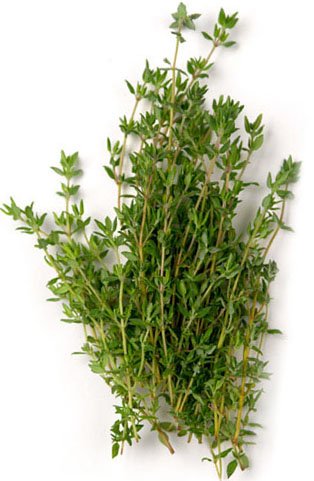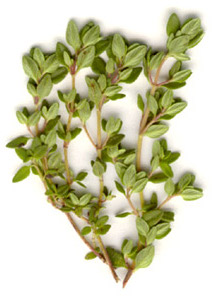

Thyme

Thymus. (From Greek thyo, to perfume: thymon or thymos used by Dioscorides, probably for this plant.) THYME. Labiatae. 350 perennial, aromatic herbs and subshrubs, some gynodioecious. Leaves oval to linear, opposite, entire. Flowers crowded in terminal bracteate heads or in leaf axils; calyx uneven, upper lip 3-lobed, lower lip cleft, cylindrical or campanulate; corolla tubular, single style rising from 4-lobed ovary, stamens 4, generally protandrous. Fruit a nutlet. Distinguished from Origanum by minute leaves and uneven calyx. Eurasia. CultivationCulinary herbs and important bee plants, all thymes are strongly aromatic in favourable locations. They retain their fragrance well on drying, and are used in pot-pourri, sweet sachets and herb pillows. The essential oil contains thymol, with antiseptic, disinfectant and deodorant properties, used in toothpaste, mouthwashes and gargles. Its preservative properties were well known to the Egyptians, who used it in embalming preparations. Thymus vulgaris retains its flavour well in long slow cooking and, with bay and parsley, is an ingredient of bouquet garni and a good addition to herb vinegars. Thymus x citriodorus is lemon-flavoured; Thymus herba-barona has a distinctive caraway flavour, suited to use with game, meat, and wines, and for cooking with garlic. Thymus species are strongly aromatic plants for dry sunny borders, open scree, troughs, rock gardens, herb gardens and between paving stones, where low-growing species will tolerate treading. The nectar-rich flowers are very attractive to honey bees. Thymus praecox, Thymus x ciriodorus, Thymus serphyllum, Thymus vulgaris and Thymus pseudolanuginosus are reliably hardy to -15ºC; other species at least -10ºC, but in cold climates should be protected with a dry mulch of bracken litter or evergreen prunings. Thymus broussonetii and Thymus ciliatus are best grown in pans in the alpine house. Grow in well-drained, preferably calcareous soils, in full sun. Clip over after flowering to maintain vigour and compactness. Harvest in early and late summer just before flowers open and dry quickly. In the alpine house, grow in a gritty, low-fertility, loam-based medium. Trim over after flowering to maintain compactness. Propagate by division, by simple layering, and from 5-8cm semi-ripe heel cuttings in spring or summer. Also from spring-sown seed; in cold climates. Thymus vulgaris for culinary use may be best grown as an annual. Thymus x citriodorus
(Thymus pulegioides x Thymus vulgaris.) Lemon-scented. Stem erect, to 30cm, pubescent. Leaves to 1cm, narrow, rhombic-oval to lanceolate, revolute. Inflorescence oblong, interrupted; bracts leaf-like; corolla pale lilac. Garden origin. ‘Anderson’s Gold’: dwarf, carpeting, foliage bright golden all winter. ‘Archer’s Gold’: compact; leaves bright yellow. ‘Argenteus’: leaves silver. ‘Argenteus Variegatus’: compact; leaves narrow, edged silver. ‘Aureus’: erect small bush to 15cm; leaves green dappled gold, most apparent in winter and early spring; liable to revert to green form. ‘Doone Valley’: prostrate, Leaves dark green splashed gold, tinted red in winter. ‘Fragrantissimus’: upright, slender; leaves grey-green; orange-scented; flowers pale pink on white. ‘Golden King’: upright, bushy; leaves edged gold. ‘Golden Queen’: loose; leaves pale green lightly variegated gold; flowers mauve. ‘Minus’: miniature. ‘Nyewoods’: minute leaves intricately veined, pale green-yellow and bearing a green central stripe. ‘Silver Queen’: variably variegated from finely marbled cream to dull silver; terminal leaf buds turn rose-pink in winter. Z7. Thymus herba-baronaCARAWAY THYME. Dwarf subshrub to 25cm, wiry, forming loose carpet. Leaves minute, dark green, pubescent. Flowers in lax low-lying heads; corolla pink or mauve. Mid-summer. Corsica and Sardinia. ‘Caraway-scented’: very heavily scented. ‘Lemon-scented’: strongly scented of lemons. Thymus vulgarisStems to 30cm, vertical, often branching, lower parts woody. Leaves to 8 x 2.5mm, linear to lanceolate, pubescent below, revolute. Flowers crowded in whorls; bracts similar to leaves, grey green; calyx to 4mm, campanulate; corolla white or purple. W Mediterranean. ‘Argenteus’: leaves edged silver. ‘Aureus’: foliage yellow-gold; flowers rose-purple. ‘Compactus’: dense, to 10cm high; leaves pale green tinted grey. ‘Erectus’: distinctive growth, like a slow-growing miniature yew, camphor-scented; foliage narrow and green-grey, terminal heads of flowers white. ‘French’: leaves narrow, tinted grey, sweeter fragrance. ‘Silver Posie’: leaves silver-variegated; flowers delicate mauve. Z7. There are many more species of the genus Thymus but the three featured above are the ones used for culinary purposes.
|
Home
Grow Nuts
Grow Fruit
Grow Vegetables
Cyberian Index
If you like this website and want one of your own contact
Cyberian All information correct at
time of publication and open to updates as necessary. No part of this website,
or its vectors, may be produced in any shape or form, using any type or design
of medium, system, equipment or otherwise without the prior written consensual
notice of the Cyberian. Any breach of these requirements will result in the
appropriate action. If in doubt, e-mail contact is recommended.
Some components of this website were obtained as open-source software and are
used in the same non-profit manner on this website.